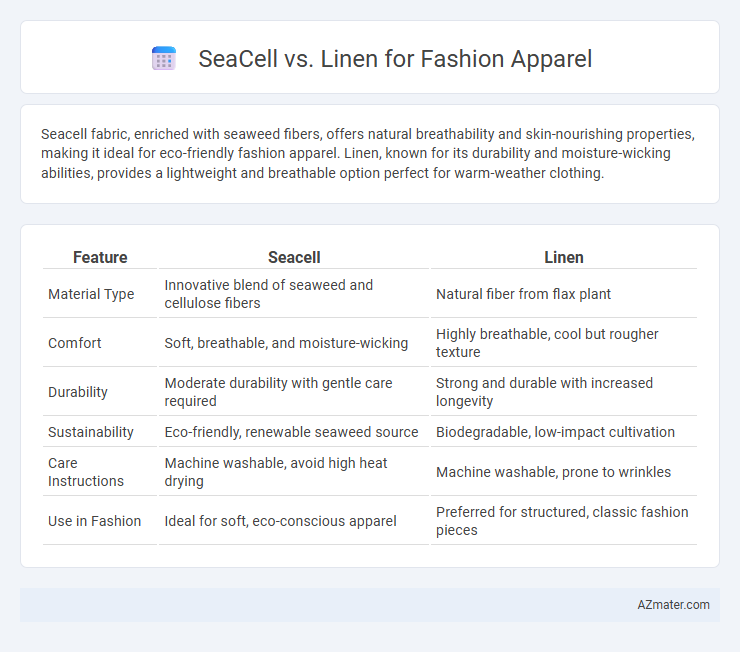Seacell fabric, enriched with seaweed fibers, offers natural breathability and skin-nourishing properties, making it ideal for eco-friendly fashion apparel. Linen, known for its durability and moisture-wicking abilities, provides a lightweight and breathable option perfect for warm-weather clothing.
Table of Comparison
| Feature | Seacell | Linen |
|---|---|---|
| Material Type | Innovative blend of seaweed and cellulose fibers | Natural fiber from flax plant |
| Comfort | Soft, breathable, and moisture-wicking | Highly breathable, cool but rougher texture |
| Durability | Moderate durability with gentle care required | Strong and durable with increased longevity |
| Sustainability | Eco-friendly, renewable seaweed source | Biodegradable, low-impact cultivation |
| Care Instructions | Machine washable, avoid high heat drying | Machine washable, prone to wrinkles |
| Use in Fashion | Ideal for soft, eco-conscious apparel | Preferred for structured, classic fashion pieces |
Introduction to Seacell and Linen Fabrics
Seacell fabric, derived from natural seaweed and wood pulp cellulose, offers sustainable and skin-friendly properties with enhanced moisture retention and anti-aging benefits, making it a popular choice in eco-conscious fashion apparel. Linen, made from flax fibers, is renowned for its breathability, durability, and natural texture, providing exceptional comfort and a lightweight feel ideal for warm-weather clothing. Both fabrics emphasize sustainability, with Seacell focusing on bioactive compounds and Linen excelling in strength and moisture-wicking capabilities, shaping distinct advantages in fashion textile applications.
Origins and Production Processes
Seacell fabric combines cellulose fibers derived from wood pulp with sustainably harvested seaweed, integrating bioactive elements into textiles through an eco-friendly spinning process. Linen originates from flax plants, cultivated primarily in Europe, where fibers are extracted via retting, drying, and scutching before being spun into yarn; this traditional method emphasizes natural durability and breathability. Both materials highlight sustainable production, but Seacell incorporates marine-based nutrients, whereas linen focuses on plant-based fiber refinement.
Sustainability and Environmental Impact
Seacell fabric, infused with seaweed fibers, offers enhanced sustainability by promoting biodegradability and reducing chemical use in production compared to traditional linen made from flax plants. Linen has a lower water footprint and requires fewer pesticides than cotton, but Seacell's natural seaweed content provides additional skin benefits and supports ocean ecosystems. Both materials contribute to eco-friendly fashion, yet Seacell's innovation in blending marine resources with textiles marks a significant advancement in reducing environmental impact.
Fabric Properties and Feel
Seacell fabric, enriched with seaweed and cellulose fibers, offers excellent moisture-wicking and anti-bacterial properties, making it ideal for sustainable fashion apparel with a soft, smooth feel. Linen, derived from flax fibers, is highly breathable and durable, providing a crisp texture and natural wrinkle resistance that improves with wear. The combination of Seacell's skin-nourishing benefits and linen's strength makes both fabrics popular choices for eco-friendly, comfortable clothing.
Breathability and Moisture Management
Seacell fabric, infused with seaweed fibers, offers superior moisture management by absorbing sweat and releasing skin-beneficial nutrients, making it highly breathable and comfortable for fashion apparel. Linen, derived from flax fibers, excels in breathability due to its natural fiber structure, promoting quick drying and airflow. While linen provides excellent ventilation and durability, Seacell's added skin-friendly properties and moisture regulation give it an edge in advanced comfort technology for active or sensitive skin wear.
Durability and Longevity
Seacell fabric, enriched with seaweed fibers, offers moderate durability with natural moisture-wicking properties but tends to be less resistant to wear and frequent washing compared to linen. Linen, made from flax fibers, is renowned for its exceptional strength and long-lasting resilience, making it highly durable for fashion apparel subjected to regular use. Over time, linen maintains structural integrity and softens without significant degradation, whereas Seacell may exhibit faster wear, influencing overall garment longevity.
Skin Benefits and Hypoallergenic Qualities
Seacell fabric, infused with seaweed fibers, offers enhanced skin benefits by releasing antioxidants and vitamins that promote skin hydration and reduce inflammation, making it ideal for sensitive skin. Linen, derived from flax fibers, naturally provides excellent breathability and moisture-wicking properties, supporting skin health through improved air circulation and reduced irritation. Both materials are hypoallergenic, but Seacell's bioactive components give it a unique advantage in soothing and protecting allergy-prone or delicate skin in fashion apparel.
Versatility in Fashion Design
Seacell fabric, enriched with seaweed fibers, offers exceptional moisture-wicking and antibacterial properties, making it ideal for eco-friendly, comfortable fashion apparel. Linen, known for its breathability and natural texture, provides a timeless and lightweight option suited for both casual and formal wear. Both materials enable versatile fashion designs, with Seacell lending itself to innovative sustainable pieces while linen supports classic, breathable styles perfect for warm climates.
Price Comparison and Market Availability
Seacell fabric, known for its eco-friendly properties and skin benefits, typically commands a higher price point than linen due to its innovative production process and limited manufacturing sites. Linen is widely available across global markets at a lower cost, benefiting from established supply chains and large-scale cultivation of flax fibers. Fashion brands often choose linen for cost-effective mass production, while Seacell is favored in premium segments prioritizing sustainability and unique fiber technology.
Choosing Between Seacell and Linen for Your Wardrobe
Seacell fabric merges the benefits of seaweed-infused fibers with natural cellulose, offering moisture-wicking and skin-nourishing properties ideal for sensitive skin, while linen stands out with its durability, breathability, and timeless texture suitable for hot climates. Choosing between Seacell and linen depends on your preference for functional skincare fabric versus traditional, long-lasting weave; both support sustainable fashion with biodegradable materials. For wardrobe versatility, Seacell blends tend to feel softer and stretch more, whereas linen maintains crispness and structure, making it perfect for tailored and casual styles alike.

Infographic: Seacell vs Linen for Fashion Apparel
 azmater.com
azmater.com